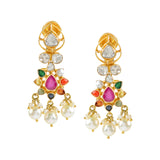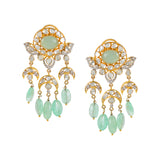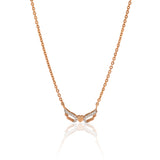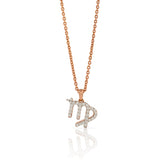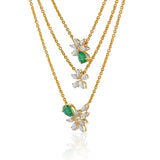Introduction:
In the kaleidoscopic tapestry of India's cultural heritage, the tradition of jewelry holds a captivating allure. South Indian jewelry, characterized by its intricate craftsmanship, rich symbolism, and opulent designs, stands as a testament to the region's artistic brilliance and historical depth. This journey through time will navigate the origins and evolution of South Indian jewelry, unveiling the cultural influences, traditional techniques, and its profound significance in various ceremonies and celebrations.
Ancient Origins and Influences:
The roots of South Indian jewelry can be traced back to ancient civilizations like the Indus Valley and the Chola dynasty. Gold, an eternal symbol of wealth and prosperity, became the cornerstone of South Indian jewelry. Influences from trade routes like the Silk Road brought precious gems like rubies, emeralds, and pearls, contributing to the vibrant palette of jewelry designs.
Temple Traditions and Iconography:
Temples played a pivotal role in shaping South Indian jewelry aesthetics. Temple sculptures and intricate carvings inspired jewelry designs that mirrored the divine grandeur. The tradition of adorning deities with ornate jewelry paved the way for human adornment. The representation of gods and goddesses wearing elaborate jewelry had a profound impact on jewelry aesthetics, influencing motifs like the sacred "kolam" (lotus), "gopuram" (temple tower), and "vilakku" (lamp), among others.
Intricate Techniques and Craftsmanship:
South Indian jewelry is a testament to the virtuosity of skilled artisans. Time-honored techniques such as "nakshi" (hand engraving), "kundan" (stone setting), and "meenakari" (enamel work) adorn the jewelry pieces with a sublime intricacy. "Temple jewelry," renowned for its distinctive appearance, involves the "kempu" technique, wherein rubies are set amidst gold foil to create a captivating contrast.
Jewelry for Ceremonies and Celebrations:
South Indian jewelry transcends mere ornamentation; it's a vital aspect of ceremonies and celebrations. "Muhurtham" or wedding ceremonies are an epitome of this, where the bride adorns herself with resplendent jewelry sets, including the "manga mala" (mango-shaped necklace) and the "vanki" (armlet), symbolizing prosperity and marital bliss. Festivals like Diwali and Pongal witness families passing down heirloom jewelry, each piece narrating a saga of tradition and heritage.
Changing Tides and Contemporary Trends:
With the passage of time, South Indian jewelry has embraced contemporary influences while maintaining its intrinsic cultural essence. The fusion of traditional motifs with modern designs has broadened the appeal, making it suitable for a range of occasions, from weddings to parties. Artisans today blend ancient techniques with innovative designs, giving rise to a vibrant market for South Indian jewelry.
Conclusion:
The evolution of South Indian jewelry is a mesmerizing journey that spans centuries, culture, and artistry. From its origins rooted in ancient civilizations to its integration into contemporary fashion, this jewelry style continues to weave a tale of intricate craftsmanship and deep-seated traditions. As a symbol of wealth, beauty, and spirituality, South Indian jewelry remains an embodiment of India's timeless heritage, captivating hearts across the globe.


